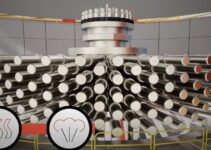
Illustration: Natalie Peeples/Axios
The path to powering the world with nuclear fusion energy involves solving key materials science and technology problems.
The big picture: This week’s announcement of a major fusion reaction advance was a demonstration of the physics at the heart of a clean energy source scientists have pursued for decades. But scientific and engineering challenges remain, particularly the development of new materials.
- “It is a long development path but it will accelerate,” says Nigel Woolsey, a professor of physics at the University of York. He estimates scientists could demonstrate a plant that produces fusion energy at scale in 10 to 20 years.
Driving the news: Researchers at the National Ignition Facility (NIF) at Lawrence Livermore National Laboratory (LLNL) in California announced they had for the first time produced more energy from a nuclear fusion reaction than the energy put into the reaction, or what’s known as ignition.
- The achievement on Dec. 5 came after decades of work and builds on earlier results.
- “You can think of it as the Moore’s Law of fusion,” says Alex Zylstra, an experimental physicist at LLNL, referencing the rapid growth in the number of transistors on silicon chips that drove the electronics industry.
How it works: NIF uses 192 high-energy laser beams that strike a gold canister containing a pellet of deuterium and tritium fuel.
- The laser light is converted to X-rays that compress the capsule and heat the fuel to 100 million degrees Celsius, driving the fusion of deuterium and tritium to produce helium. The reaction releases energy in the form of neutrons and triggers further fusion reactions.
- The experiment, or “shot,” that achieved ignition hit the fuel with 2 megajoules of energy from the lasers and yielded 3MJ.
But, but, but… The lasers themselves require more than 300MJ of energy each time to operate, meaning NIF overall generated about just 1% of the power put in.
- Fusion energy would have to be produced consistently and at far greater scales than what NIF currently produces.
- Using NIF’s approach to generate power would require 10 shots per second — as opposed to the current “once a day or so,” Zylstra says.
- There have been “huge developments in laser tech and methods for improving the smoothness of laser beams,” Woolsey says. Those could help to improve the efficiency and allow the laser to be run more often.
Keep in mind: Generating fusion power for the grid isn’t NIF’s purpose — it’s creating the conditions in nuclear explosions in order to study nuclear weapons.
What’s next: There are two main approaches to generating fusion energy — inertial confinement, which NIF uses, and magnetic confinement. Both are being pursued in various projects and by dozens of companies around the world.
- To move from physics breakthroughs to energy production requires advances in designing the materials needed for fusion reactors.
- Two reports published in the past two years identified a need to increase research and development of materials science and technology for fusion energy.
Details: The physics of the two basic approaches to fusion energy are fundamentally different but there are similarities between the materials they need to operate, says Lance Snead, a professor at Stony Brook University who specializes in radiation materials science.
- The changes in heat in the reactors and the neutrons that bombard the walls can cause damage that is “kind of like corrosion on an atomic scale,” Snead says. He adds, there’s a need for materials that can withstand high temperatures but don’t introduce impurities or generate nuclear waste.
- “We currently don’t have a solution,” he says. And scientists are limited to “a small part of the periodic table to solve [the problem].”
- Fusion also produces very high-energy neutrons whose effects on materials are unknown. The International Fusion Materials Irradiation Facility (IFMIF) is a project in development that would study candidate materials for reactors.
Of note: There is also the challenge of a supply of tritium for fuel, which both Woolsey and Snead say would likely have to be manufactured onsite.
The bottom line: “We’ve done the science. Now have to start investing in the things that will put energy on the grid,” Snead says.


